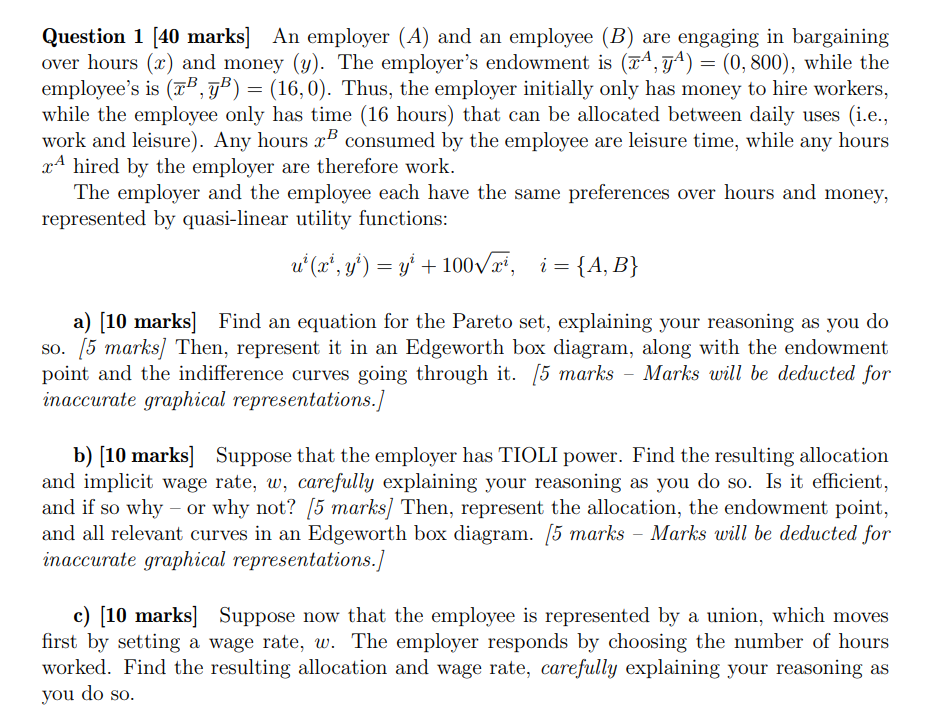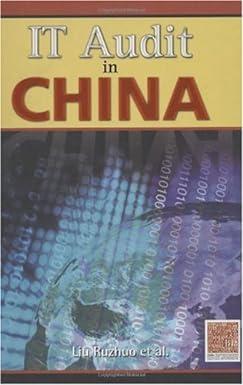


Question 1 [40 marks] An employer (A) and an employee (B) are engaging in bargaining over hours (x) and money (y). The employer's endowment is (xA,yA)=(0,800), while the employee's is (xB,yB)=(16,0). Thus, the employer initially only has money to hire workers, while the employee only has time (16 hours) that can be allocated between daily uses (i.e., work and leisure). Any hours xB consumed by the employee are leisure time, while any hours xA hired by the employer are therefore work. The employer and the employee each have the same preferences over hours and money, represented by quasi-linear utility functions: ui(xi,yi)=yi+100xi,i={A,B} a) [10 marks] Find an equation for the Pareto set, explaining your reasoning as you do so. [5 marks] Then, represent it in an Edgeworth box diagram, along with the endowment point and the indifference curves going through it. 55 marks - Marks will be deducted for inaccurate graphical representations.J b) [10 marks] Suppose that the employer has TIOLI power. Find the resulting allocation and implicit wage rate, w, carefully explaining your reasoning as you do so. Is it efficient, and if so why - or why not? [5 marks] Then, represent the allocation, the endowment point, and all relevant curves in an Edgeworth box diagram. [5 marks - Marks will be deducted for inaccurate graphical representations.] c) [10 marks] Suppose now that the employee is represented by a union, which moves first by setting a wage rate, w. The employer responds by choosing the number of hours d) [10 marks] Is your answer in c) efficient, and if so why - or why not? Compare and contrast your answer in c) with that in b), commenting in particular on the distribution of rents. [5 marks] Then, represent the allocation, the endowment point, and all relevant curves in an Edgeworth box diagram. [5 marks - Marks will be deducted for inaccurate graphical representations.] Question 2 [20 marks] Two individuals, Ann (A) and Bruce (B), populate an exchange economy. They have the same preferences over two goods, eggs (x) and bacon (y), and so we have the following utility function representations for each: uA(xA,yA)=(xA)21(yA)21 and uB(xB,yB)=(xB)21(yB)21. Their initial endowments of both goods are respectively xA=5, yA=0, and xB=0 and yB=20. a) [10 marks] Find an equation for the Pareto set, explaining your reasoning as you do so. Given the above preferences and endowments, are there potential gains from trade in this economy? Why or why not? Explain your reasoning. b) [10 marks] Choosing good y as the numraire, find the Walrasian equilibrium (i.e., the market-clearing prices and the corresponding allocation) for this economy, explaining your reasoning as you do so. d) [10 marks] Is your answer in c) efficient, and if so why - or why not? Compare and contrast your answer in c) with that in b), commenting in particular on the distribution of rents. [5 marks] Then, represent the allocation, the endowment point, and all relevant curves in an Edgeworth box diagram. [5 marks - Marks will be deducted for inaccurate graphical representations.] Question 2 [20 marks] Two individuals, Ann (A) and Bruce (B), populate an exchange economy. They have the same preferences over two goods, eggs (x) and bacon (y), and so we have the following utility function representations for each: uA(xA,yA)=(xA)21(yA)21 and uB(xB,yB)=(xB)21(yB)21. Their initial endowments of both goods are respectively xA=5, yA=0, and xB=0 and yB=20. a) [10 marks] Find an equation for the Pareto set, explaining your reasoning as you do so. Given the above preferences and endowments, are there potential gains from trade in this economy? Why or why not? Explain your reasoning. b) [10 marks] Choosing good y as the numraire, find the Walrasian equilibrium (i.e., the market-clearing prices and the corresponding allocation) for this economy, explaining your reasoning as you do so. Question 1 [40 marks] An employer (A) and an employee (B) are engaging in bargaining over hours (x) and money (y). The employer's endowment is (xA,yA)=(0,800), while the employee's is (xB,yB)=(16,0). Thus, the employer initially only has money to hire workers, while the employee only has time (16 hours) that can be allocated between daily uses (i.e., work and leisure). Any hours xB consumed by the employee are leisure time, while any hours xA hired by the employer are therefore work. The employer and the employee each have the same preferences over hours and money, represented by quasi-linear utility functions: ui(xi,yi)=yi+100xi,i={A,B} a) [10 marks] Find an equation for the Pareto set, explaining your reasoning as you do so. [5 marks] Then, represent it in an Edgeworth box diagram, along with the endowment point and the indifference curves going through it. 55 marks - Marks will be deducted for inaccurate graphical representations.J b) [10 marks] Suppose that the employer has TIOLI power. Find the resulting allocation and implicit wage rate, w, carefully explaining your reasoning as you do so. Is it efficient, and if so why - or why not? [5 marks] Then, represent the allocation, the endowment point, and all relevant curves in an Edgeworth box diagram. [5 marks - Marks will be deducted for inaccurate graphical representations.] c) [10 marks] Suppose now that the employee is represented by a union, which moves first by setting a wage rate, w. The employer responds by choosing the number of hours d) [10 marks] Is your answer in c) efficient, and if so why - or why not? Compare and contrast your answer in c) with that in b), commenting in particular on the distribution of rents. [5 marks] Then, represent the allocation, the endowment point, and all relevant curves in an Edgeworth box diagram. [5 marks - Marks will be deducted for inaccurate graphical representations.] Question 2 [20 marks] Two individuals, Ann (A) and Bruce (B), populate an exchange economy. They have the same preferences over two goods, eggs (x) and bacon (y), and so we have the following utility function representations for each: uA(xA,yA)=(xA)21(yA)21 and uB(xB,yB)=(xB)21(yB)21. Their initial endowments of both goods are respectively xA=5, yA=0, and xB=0 and yB=20. a) [10 marks] Find an equation for the Pareto set, explaining your reasoning as you do so. Given the above preferences and endowments, are there potential gains from trade in this economy? Why or why not? Explain your reasoning. b) [10 marks] Choosing good y as the numraire, find the Walrasian equilibrium (i.e., the market-clearing prices and the corresponding allocation) for this economy, explaining your reasoning as you do so. d) [10 marks] Is your answer in c) efficient, and if so why - or why not? Compare and contrast your answer in c) with that in b), commenting in particular on the distribution of rents. [5 marks] Then, represent the allocation, the endowment point, and all relevant curves in an Edgeworth box diagram. [5 marks - Marks will be deducted for inaccurate graphical representations.] Question 2 [20 marks] Two individuals, Ann (A) and Bruce (B), populate an exchange economy. They have the same preferences over two goods, eggs (x) and bacon (y), and so we have the following utility function representations for each: uA(xA,yA)=(xA)21(yA)21 and uB(xB,yB)=(xB)21(yB)21. Their initial endowments of both goods are respectively xA=5, yA=0, and xB=0 and yB=20. a) [10 marks] Find an equation for the Pareto set, explaining your reasoning as you do so. Given the above preferences and endowments, are there potential gains from trade in this economy? Why or why not? Explain your reasoning. b) [10 marks] Choosing good y as the numraire, find the Walrasian equilibrium (i.e., the market-clearing prices and the corresponding allocation) for this economy, explaining your reasoning as you do so









